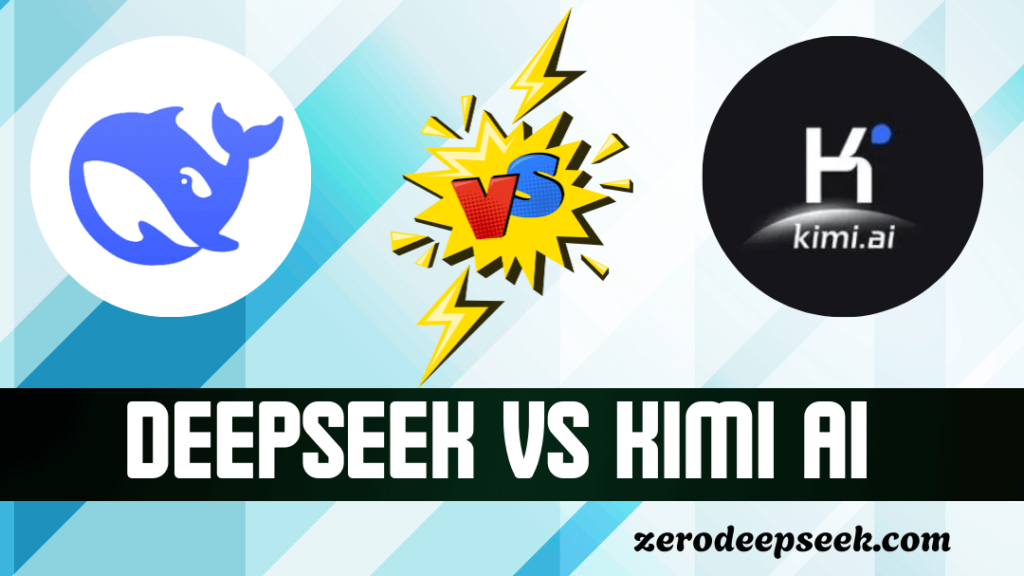The AI landscape is brimming with tools promising to revolutionize workflows, but selecting the right one can be daunting. Two standout platforms—DeepSeek and Kimi AI—offer distinct approaches to AI-driven solutions. Whether you’re a developer building custom models or a small business owner seeking quick deployment, this guide breaks down the strengths, limitations, and ideal use cases for each platform to help you make an informed decision.

What is DeepSeek?
DeepSeek is a versatile AI platform designed for developers, data scientists, and enterprises. It offers advanced tools for text generation, coding assistance, data analysis, and customizable AI models. Known for its robust APIs and seamless integration with developer ecosystems, DeepSeek is ideal for users who need scalability and technical flexibility.
What is Kimi AI?
Kimi AI is a no-code AI platform tailored for SMEs and non-technical users. It focuses on industry-specific solutions like customer service chatbots, multilingual support, and pre-built templates for quick deployment. Kimi’s drag-and-drop interface makes it accessible for businesses seeking fast, out-of-the-box AI solutions.
DeepSeek vs. Kimi AI: A Feature-by-Feature Comparison
1. Core Features
- DeepSeek:
- Text generation, coding assistance, and data analysis.
- Customizable models for niche applications.
- Advanced APIs for integration with developer tools.
- Kimi:
- Pre-built templates for chatbots and customer service tools.
- Industry-specific solutions (e.g., healthcare, retail).
- Drag-and-drop interface for non-technical users.
Winner: DeepSeek for technical versatility; Kimi for ease of use.
2. Target Audience
- DeepSeek: Developers, data scientists, and enterprises.
- Kimi: SMEs and non-technical users.
Winner: Depends on your technical expertise and business size.
3. Performance
- DeepSeek:
- High-speed processing for large datasets.
- Cutting-edge neural architectures for complex tasks.
- Kimi:
- Optimized for accuracy in niche applications.
- May lag in raw computational power compared to DeepSeek.
Winner: DeepSeek for scalability and performance.
4. Ease of Use
- DeepSeek: Requires technical expertise for setup and customization.
- Kimi: User-friendly interface with no coding required.
Winner: Kimi for simplicity; DeepSeek for advanced users.
5. Integration & Compatibility
- DeepSeek:
- Integrates with cloud platforms (AWS, Azure) and developer tools (VS Code, Jupyter).
- Extensive API support for custom workflows.
- Kimi:
- Pre-built connectors for CRM systems (Salesforce, Zendesk).
- Collaboration tools (Slack, Teams) for seamless deployment.
Winner: DeepSeek for developer ecosystems; Kimi for plug-and-play solutions.
6. Pricing
- DeepSeek: Tiered subscription starting at $99/month for startups.
- Kimi: Pay-as-you-go model ($0.005/request) with free tiers for low-volume use.
Winner: Kimi for affordability; DeepSeek for enterprise scalability.
7. Support & Community
- DeepSeek: 24/7 enterprise support, active developer forums, and detailed documentation.
- Kimi: Knowledge base and email support; emerging community forums.
Winner: DeepSeek for comprehensive support.
8. Security & Compliance
- DeepSeek: GDPR/CCPA compliant, end-to-end encryption, and SOC 2 certification.
- Kimi: Basic encryption and regional compliance.
Winner: DeepSeek for enterprise-grade security.
Use Cases: Who Should Choose What?
DeepSeek is Ideal For:
- Developers: Building custom AI models or integrating AI into existing workflows.
- Enterprises: Handling large-scale data processing and complex tasks.
- Tech/Finance Sectors: Needing advanced AI solutions for niche applications.
Example: A fintech startup uses DeepSeek to analyze transaction data and detect fraud patterns in real time.
Kimi AI is Ideal For:
- SMEs: Seeking quick, no-code AI solutions for customer engagement.
- Non-Technical Users: Deploying chatbots or automating repetitive tasks.
- Niche Industries: Healthcare, retail, or hospitality needing pre-built templates.
Example: A small e-commerce store uses Kimi to deploy a multilingual chatbot for customer support.
Limitations
DeepSeek:
- Complex Setup: Requires technical expertise for customization.
- Higher Costs: Premium pricing for advanced features.
Kimi AI:
- Limited Customization: Less flexibility for unique use cases.
- Scalability Constraints: May struggle with large-scale operations.
Conclusion
Choosing between DeepSeek and Kimi depends on your technical expertise, business size, and specific needs. DeepSeek shines in advanced customization, scalability, and enterprise-grade security, making it ideal for developers and large organizations. On the other hand, Kimi offers simplicity, affordability, and quick deployment, catering to SMEs and non-technical users.
FAQs
1. Can I switch from Kimi to DeepSeek later?
Yes, but migration may require technical expertise to adapt workflows.
2. Which platform is better for startups?
Kimi is more cost-effective for startups with limited budgets, while DeepSeek suits tech-heavy startups needing scalability.
3. Does Kimi support multilingual chatbots?
Yes, Kimi offers multilingual support for customer service tools.
4. Can DeepSeek integrate with Salesforce?
Yes, but it requires API customization, whereas Kimi offers pre-built connectors.
5. Which platform is more secure?
DeepSeek offers enterprise-grade security (SOC 2, GDPR), making it better for regulated industries.


